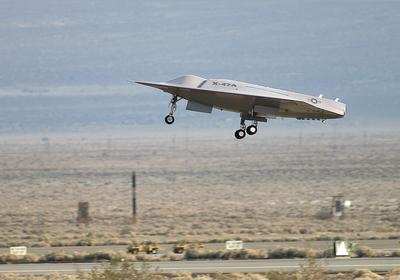Aimed At Reducing Development Risks for X-47B Combat UAV
Northrop Grumman Corporation has opened a new system integration
laboratory (SIL) to help identify any potential hardware, software
or system cost issues related to the development of its X-47B
combat unmanned air vehicle long before the first air vehicle
flies.
The company-funded facility, which is located at Northrop
Grumman's Unmanned Systems unit in San Diego, opened October 15. It
will support the company's current work on a $1.04 billion contract
with the Defense Advanced Research Projects Agency (DARPA) for the
operational assessment phase of the Joint Unmanned Combat Air
Systems (J-UCAS) Concept Demonstration program.

"Having a SIL is all about reducing technical and financial
risk," said Scott Winship, Northrop Grumman's J-UCAS program
manager. "Since we don't have pilots to flight test UAVs, we rely
heavily on the SIL to test every aspect of a UAV before it flies,
from single lines of software code to complete system testing. For
the X-47B, we will even have two 'iron birds' in the lab - that is,
two systems with nearly every aspect of the final air vehicle
except the engine. We want to make sure every aspect of our system
is ready for flight before it reaches the flight line."
The centerpiece for Northrop Grumman's new SIL is a
2,600-square-foot system center, which contains workstations for
operational flight program development, mission software
development, software robustness testing and integration, and a
crew rehearsal room for performing simulated mission scenarios and
contingency training for engineers and air vehicle operators.
Adjacent to the system center is a 3,000-square foot laboratory
space that will support the systems center and allow engineers,
software developers and testers to develop and qualify flight
software as well as integrate all vehicle subsystems.
Northrop Grumman's current J-UCAS contract with DARPA calls for
it to produce and flight-test threeX-47B unmanned demonstration
vehicles with associated mission-control stations and logistical
support elements. Flight demonstrations of the air vehicles are
expected to begin in 2007.
The US Department of Defense established the J-UCAS program in
the fall of 2003 to demonstrate the technical feasibility, military
utility and operational value of developing a network of high
performance, survivable, and weaponized unmanned aerial vehicles.
These air vehicles will conduct a variety of 21st-century combat
missions for both the US Air Force and the US Navy including
precision targeting and strike; persistent intelligence,
surveillance and reconnaissance; suppression of enemy air defenses;
and electronic attack.
Northrop Grumman's efforts to design, develop and produce an
unmanned combat air system that satisfies the operational
requirements of both services is managed by the company's
Integrated Systems sector. Its J-UCAS concept builds on the
company's highly successful X-47A, Pegasus, program, and extensive
experience with autonomous flight control systems, including
thousands of flight hours by its combat-proven RQ-4 Global Hawk
unmanned reconnaissance system and the RQ-8 Fire Scout vertical
takeoff and landing tactical unmanned system.

Northrop Grumman Integrated Systems is a premier aerospace and
defense systems integration organization. Headquartered in El
Segundo (CA) it designs, develops, produces and supports integrated
systems and subsystems optimized for use on networks. For its
government and civil customers worldwide, Integrated Systems
delivers best-value solutions, products and services that support
military and homeland defense missions in the areas of
intelligence, surveillance and reconnaissance; space access; battle
management command and control; and integrated strike warfare.
 ANN's Daily Aero-Linx (05.06.25)
ANN's Daily Aero-Linx (05.06.25) ANN's Daily Aero-Term (05.06.25): Ultrahigh Frequency (UHF)
ANN's Daily Aero-Term (05.06.25): Ultrahigh Frequency (UHF) ANN FAQ: Q&A 101
ANN FAQ: Q&A 101 Classic Aero-TV: Virtual Reality Painting--PPG Leverages Technology for Training
Classic Aero-TV: Virtual Reality Painting--PPG Leverages Technology for Training Airborne 05.02.25: Joby Crewed Milestone, Diamond Club, Canadian Pilot Insurance
Airborne 05.02.25: Joby Crewed Milestone, Diamond Club, Canadian Pilot Insurance



